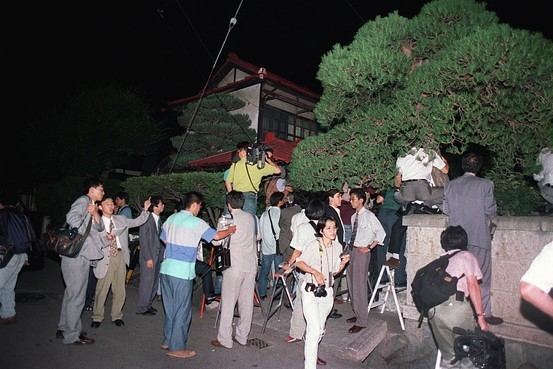Weapons Sarin Number of deaths 8 | Non-fatal injuries 200+ Dates 27 Jun 1994 – 28 Jun 1994 | |
 | ||
Motive Attempt to assassinate judges presiding over criminal charges against Aum Shinrikyo Similar | ||
ex suspect speaks up before 20th anniv of matsumoto sarin attack
The Matsumoto sarin attack was an act of domestic terrorism perpetrated by members of the Aum Shinrikyo doomsday cult in Matsumoto, in Japan's Nagano prefecture, on the night of 27 June, 1994. Eight people were killed and over 200 were harmed by sarin gas that was released from a converted refrigeration truck in the Kaichi Heights area. The attack was perpetrated nine months before the better known Tokyo subway sarin attack.
Contents
Gas attack
The gas attack occurred in a quiet residential area in the city of Matsumoto in Nagano Prefecture. Aum Shinrikyo had two goals; to attack three judges who were overseeing a lawsuit concerning a real-estate dispute which was predicted to go against the cult, and to test the efficiency of its sarin — which the cult was manufacturing at one of its facilities — as a weapon of mass-murder. The citizens of Matsumoto had angered Aum Shinrikyo founder Shoko Asahara by vigorously opposing his plan to set up an office and factory on land in southern Matsumoto. Opponents of the plan gathered 140,000 signatures on an anti-Aum Shinrikyo petition, equivalent to 70 percent of the city’s population at the time.
The cult's original plan to release the gas into the Matsumoto courthouse was altered when the cult members arrived in the city after the courthouse had closed. The cult members decided to instead target a three-story apartment building where the city's judges resided. At 10:40pm, members of Aum Shinrikyo used a converted refrigerator truck to release a cloud of sarin which floated near the home of the judges. The truck’s cargo space held a heating contraption that had been specifically designed to turn 12 litres of liquid sarin into gas, and fans to diffuse the gas into the judges' neighbourhood.
At 11:30pm, Matsumoto police received an urgent report from paramedics that multiple casualties were being been transported to hospital. The patients were suffering from darkened vision, eye pain, headaches, nausea, diarrhoea, miosis, and numbness in their hands. Some victims described having seen a fog with a pungent and irritating smell floating by. A total of 274 people were treated. Five dead residents were discovered in their apartments, and two died in hospital immediately after admission. An eighth victim, Sumiko Kono, remained in a coma for 14 years and died in 2008.
The day after the attack, dead fish were found in a pond near the scene. The bodies of dogs, birds, and a large number of caterpillars were found in the area. Grass and trees had withered and the trees' leaves had discoloured. Nearly all of the casualties had been discovered within a radius of 150 metres from the centre, near the pond. People near open windows or in air-conditioned rooms had been exposed to the gas.
On 3 July, officials announced that the toxic agent in the gas cloud had been identified as sarin using gas chromatography–mass spectrometry. The fatalities included Yutaka Kobayashi, a 23-year-old salaried worker, and Mii Yasumoto, a 29-year-old medical school student. The sarin used in the incident was nearly pure.
Investigation
Police received an anonymous tip implicating Aum Shinrikyo after the gas attacks but the sect was not officially implicated in the incident until after the later Tokyo subway sarin attack. One section of the tip read, "Matsumoto was definitely an experiment of sorts. The result of this experiment in an open space: seven dead, over 200 injured. If sarin is released in an enclosed space say, a crowded subway it is easy to imagine a massive catastrophe."
After the incident, police focused their investigation on Yoshiyuki Kōno, whose wife was a victim put in a coma by the gas. It was discovered that Kōno had stored a large amount of pesticide in his residence. Despite the fact that sarin cannot be manufactured from pesticides, Keiichi Tsuneishi, a Japanese historian, claimed the nerve agent is synthesizable from organophosphorus pesticides, and Kōno was dubbed by some in the media "the Poison Gas Man" and received hate mail, death threats, and intense legal pressure. After he was found innocent, every major Japanese newspaper apologized to Kōno, including those who did not name him as a suspect.
After the attack on the Tokyo subway in 1995, the blame was shifted to the cult Aum Shinrikyo. The police chief, on behalf of the police department and media, publicly apologized to Kōno. Kōno's wife later woke up from coma, but recovered neither speech nor body movement and eventually died in 2008.
Several Aum Shinrikyo members were found guilty of masterminding both incidents. Combined, the attacks resulted in 21 deaths and thousands of hospitalizations or outpatient treatment. The main motive for the Matsumoto incident was trying to kill the judges handling fraud charges against Aum brought by land owners in Matsumoto, in order to prevent the court from releasing the scheduled verdict.
